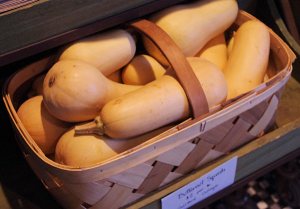Rhubarb: why the misunderstood vegetable makes the best margarita, coulis, pie, and BBQ sauce
LOCAVORE’S DELIGHT: The Series #29. Follow us as we explore the bounty of our region’s farms.
Rhubarb is one of the most misunderstood ingredients on menus. You’ll see it at the grocery store, but it’s difficult to find at the Farmer’s Market (both Cary and Greensboro Farmer’s Markets say it’ll be a few more weeks before we see any). It’s a perennial, but not grown everywhere. It’s a vegetable, but used like a fruit.
The oxalic acid content of rhubarb makes the leaves poisonous, and the stem, delicious. While rhubarb is grown in some cold pockets in North Carolina, good rhubarb needs the ground to freeze, and grows best in Michigan and Oregon.
Try the Lattice-Crust Rhubarb Pie with Homeland Creamery vanilla ice cream available now at Lucky 32 Southern Kitchen on the Spring’s Eternal Menu, now until May 14.
It’s a vegetable. In some places, a spring perennial. And is a key component of a delicious margarita, also adding to the confusion:
- It’s naturally sour, which is not the most preferred taste sensation in America – only slightly more popular than bitter. The sour comes from its oxalic acid content.
- It’s odd-looking. It’s a stalk. People don’t celebrate celery, or cardoons (another stalk that is an artichoke relative in thistle family) like they do cute fruits, like apples, blackberries and tomatoes.
What makes rhubarb a vegetable? Sugar content?
Rhubarb is a vegetable despite its prescient use in fruit pies, jams, and coulis.
Fruit is something a plant produces to nourish its the seeds.. When you pick an apple you don’t kill an apple tree, but you do have to kill the plant to eat a vegetable. For example, if you pick an onion or a beet, you’re taking the whole plant with you. When harvesting rhubarb, you pull the entire stalk from the ground, and only harvest two at a time, leaving at least five stalks for the next season’s crop.
Why is it always appearing with strawberries?
Spring is the most difficult time of year to eat fresh produce. Most plants have just begun to grow, and they are weeks from bearing edible fruit.
Rhubarb is one of the first edibles available in the spring. Its peak coincides with strawberries, so most people encounter rhubarb in one of three ways:
- Strawberry-rhubarb pie
- Stewed with an ice cream or custard
- In a jam or chutney

Strawberry-Rhubarb Pie? Not so much.
In a strawberry-rhubarb pie, we think the rhubarb plays second fiddle. Strawberries are celebrated. They’re super sweet and need contrast. You almost never see a strawberry pie on its own. There’s no complexity. It’s like a sugar bomb.
Rhubarb, when mixed with strawberries, gives you that sourness to balance the sweetness and the complexity.
We prefer to go all the way in the other direction and make rhubarb pie. No strawberry.
We make it with a lattice crust for two reasons: One, it’s cute. Two, it vents the pie so the filling can thicken up and the steam can escape.
A sour sweet
Whether you eat sour dishes to aid in digestion or you just prefer to end your meal with something less sweet, a dessert like rhubarb pie is always a welcome sight, with its delightful balance of sweet and sour.
We do a couple of things here with rhubarb that you can start doing at home, too. Recipes posted below.
- Rhubarb margarita
- Rhubarbecue sauce tastes like a sauce from down east and we put it on our grilled shrimp
- Stewed rhubarb — chop it up, sauté, deglaze with a little bit of water, dry white wine or sweet white wine. Sprinkle with sugar. Reduce and serve it with ice cream.
RECIPES
Rhubarb Margarita
- 1 fl oz Rhubarb Syrup (see recipe)
- 2 fl oz Tequila
- ¾ fl oz Cointreau
- juice from 1 wedge of lime
- ½ fl oz sour mix
- 1 wheel of lime
Salt rim of a martini glass. Add all ingredients (except lime wheel) to a cocktail shaker with ice. Shake vigorously and strain into a martini glass. Garnish with lime wheel.
Makes – 1
Rhubarb Syrup
- ½ pound rhubarb
- ¼ cup water
- 1 cup granulated sugar
Wash and dice rhubarb to ¼ inch. In a sauce pot combine rhubarb and water. Simmer for 10 minutes or until tender. Puree in food processor and strain through fine chinois, discard solids. In a sauce pot combine pureed rhubarb and sugar. Simmer until dime sized bubbles appear. Remove from heat and cool.
Makes – 1 ½ cups
Rhubarbecue Sauce
- 1 2/3 pounds rhubarb
- 2 cups apple cider vinegar
- 2/3 cup water
- 3 1/3 cups light brown sugar
- 1 teaspoon allspice
- ¼ teaspoon cayenne pepper
Clean and chop rhubarb. Combine all ingredients in a sauce pot and simmer for 30-45 minutes or until rhubarb is completely soft. Puree in blender and strain through a medium-hole strainer. Discard pulp. Place puree in a sauce pot and simmer until dime size bubbles appear. Cool.
Makes – 1 quart
For more about our seasonal recipes, see our current menu at Lucky 32 Southern Kitchen and our Blog Recipe Index:http://lucky32southernkitchen.com/recipes/











